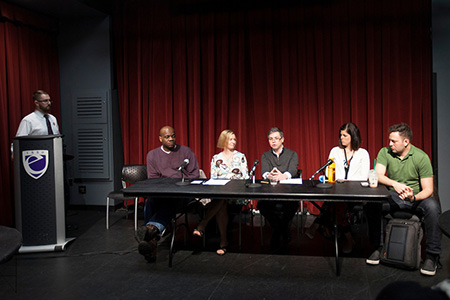Challenges of student veterans discussed

A panel of mostly veterans, two of whom are current Emerson students, discussed the challenges of student veterans at a Lunch & Learn event organized by the Office of Diversity and Inclusion on April 22. From left, Nate Magunski of the Office of Student Success, Jamil Brown, MFA '15, Laura Piscopo of the Department of Veterans' Services, Christopher Milot of the Enrollment Office, Alissa Bennett of the VA, and Daniel Roman, MFA '15. (Photo by Nydia Hartono '16)
Emerson typically has between 7 and 10 students per year who are military veterans, but that number could very well grow.
Nate Magunski, assistant director of retention and student success at Emerson, said that over the next decade, the number of college student veterans in the United States is expected to increase from 800,000 to 1.4 million as the nation continues to remain in active missions overseas.
“We need to be in a position to…make sure we are able to offer them the services they need,” Magunski said.
Magunski moderated a Lunch and Learn panel discussion organized by the Office of Diversity and Inclusion on April 22 in the Max Mutchnick Campus Center, which focused on student veterans and their unique set of issues—ranging from obtaining financial benefits for college to interacting with less mature students in the classroom while battling post-traumatic stress disorder (PTSD).
“What you’re doing right now is a huge step—having that dialogue,” said panelist Laura Piscopo, a veteran who is director of administration at the state Department of Veterans’ Services. “It’s daunting to have had certain experiences and then be dropped into a pool of 18-year-olds.”
On the panel were four veterans, including Piscopo and two Emerson graduate students who served in combat: Daniel Roman, MFA ’15, and Jamil Brown, MFA ’15, whose foot was amputated after he was injured in an explosion.
Also on the panel were Christopher T. Milot, associate director of Emerson’s enrollment pipeline, who is a veteran; and Alisa Bennett, regional outreach agent from the Veterans Affairs’ Veterans Integration to Academic Leadership (VITAL) program.
The panelists talked about the growing number of benefits available for veterans who want to attend college—and the difficult task of sorting through the information.
“There are a lot of resources out there,” Milot said. “They’re not going to put it together for you in a nice format like we’re used to. It’s up to the individual to seek out that information and find out what’s best for you.”
“Making people aware of what is out there is the biggest challenge,” Bennett said.
Piscopo, who said she dropped out of college in the early 1990s after hearing discouraging remarks from a college administrator who learned she had enlisted, spoke in favor of more gathering places and resource groups for veterans on campuses.
Roman, Brown, and Milot all said they suffered from PTSD.
“One hundred percent of veterans have some kind of PTSD,” Roman said.
Roman said some of his classmates stopped speaking with him when he revealed his diagnosis.
“They got scared,” he said. “I’m not an animal in a cage. I was getting help. But you hear a lot of bad stories [about veterans being violent]. That’s what gets out in the media.”
“It’s all right to say, ‘Is there anything I can do to help you?’” Brown said. “And to try to understand where [a veteran] is coming from.”
Bennett said it was important to continue the dialogue on college campuses to help support student veterans with PTSD.
“This is why we’re here—to help erase the stigma,” Bennett said. “If veterans are talked to and have support, they do fine.”
“The life experience veterans bring into the classroom setting is tremendous,” she said.
Categories